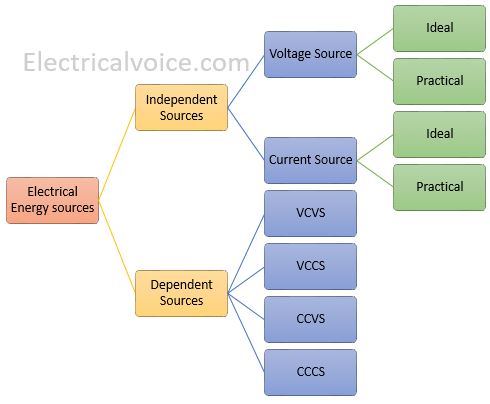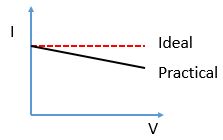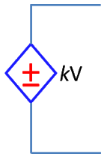Electrical energy sources are majorly classified into two classes i.e. Independent sources and Dependent sources. The independent sources are further divided into two types namely voltage source and the current source. There are four types of the dependent sources. They are as follows
1. Voltage Controlled Voltage Source (VCVS)
2. Voltage Controlled Current Source (VCCS)
3. Current Controlled Voltage Source (CCVS)
4. Current Controlled Current Source (CCCS)

Independent Sources
Ideal Voltage Source
Voltage source is an active circuit element which delivers energy to the electrical circuit with a specified terminal voltage. If the voltage of such a voltage source is independent of the current due to the absence of internal resistance it is said to an ideal voltage source.
In ideal voltage source, the load voltage is independent of load current.
Practical Voltage Source
Practically, all the voltage sources have some internal resistance in contrast to its ideal case. A practical voltage source is modelled as, an ideal voltage source in series with its internal resistance indicated by a resistor.
Due to the presence of the internal resistance, the voltage delivered by a practical voltage source is no more constant as in the ideal case, but it changes as the current changes and is dependent on the current it delivers. The voltage will drop as the current delivered by it increases.
Circuit of a practical voltage source

The fig. 1 show the practical voltage source in which the voltage delivered from the source is indicated by Vs and its internal resistance with a resistor Rs. Vt is the actual terminal voltage across the source. Hence, the terminal voltage can be obtained by applying the Kirchhoff’s voltage law (KVL) as below,
If I is the current in the loop. Then the loop equation is,
-Vs + IRs+ Vt = 0
∴ Vt= Vs – IRs
Thus, as the value of current, I increase the terminal voltage decreases.
V-I characteristics
The fig. 2 shows the V-I characteristics of a practical voltage source along with its comparison with the characteristic of an ideal source. One can observe the drop in the voltage is due to the internal resistance.

Practically, the current sources don’t have infinite resistance across them but have some finite and high resistance. Due to the finite resistance, the practical current source shows some dependency on the voltage across it. So the current delivered by a practical current is not a constant as in case of the ideal one.
Ideal Current Source
Current source is a circuit element which delivers energy with a specified current through it. If such a source maintains constant current for any voltage then it is called as an ideal current source. An ideal current source has infinite resistance (or impedance) across it.
In ideal current source, the load current is independent of load voltage.
Practical Current Source
A practical current source is modelled as an ideal current source in parallel with its internal resistance indicated by a resistor.
Circuit of a practical current source
The Fig. 1 shows the practical current source in which the current delivered from the source is indicated by Is and its internal resistance with a resistor Rs. It is the current delivered to the external circuit.

The current to delivered to the external circuit It is given by,
I=Is-(V/Rs)
V-I characteristics
The Fig. 2 shows the V-I characteristics of a practical current source along with its comparison with the characteristic of an ideal current source. The reduction of the current is due to the internal resistance Rs.

Dependent Sources
The voltage or current delivered by these sources are dependent on other circuit parameters and hence they are called as dependent sources. These are classified into four types as given under along with their circuit diagrams.
Voltage Controlled Voltage Source (VCVS)
In the voltage controlled voltage source, the voltage of the source depends on the voltage across the another branch element or terminal. It is denoted by the following symbol. Here k is the controlled variable.

Voltage Controlled Current Source (VCCS)
In the voltage controlled current source, the current of the source depends on the voltage across the another branch element or terminal. It is denoted by the following symbol.

Current Controlled Voltage Source (CCVS)
In the current controlled voltage source, the voltage source is dependent on the current of the another branch. It is denoted by the following symbol.
Current Controlled Current Source (CCCS)
In the Current Controlled Current Source, the current source is dependent on the current of the another branch. It is denoted by the following symbol.

Note: Dependent sources are linear with respect to their controlled variables.


Good explanation. Sir plz add numericals on maximum power transfer theorem.